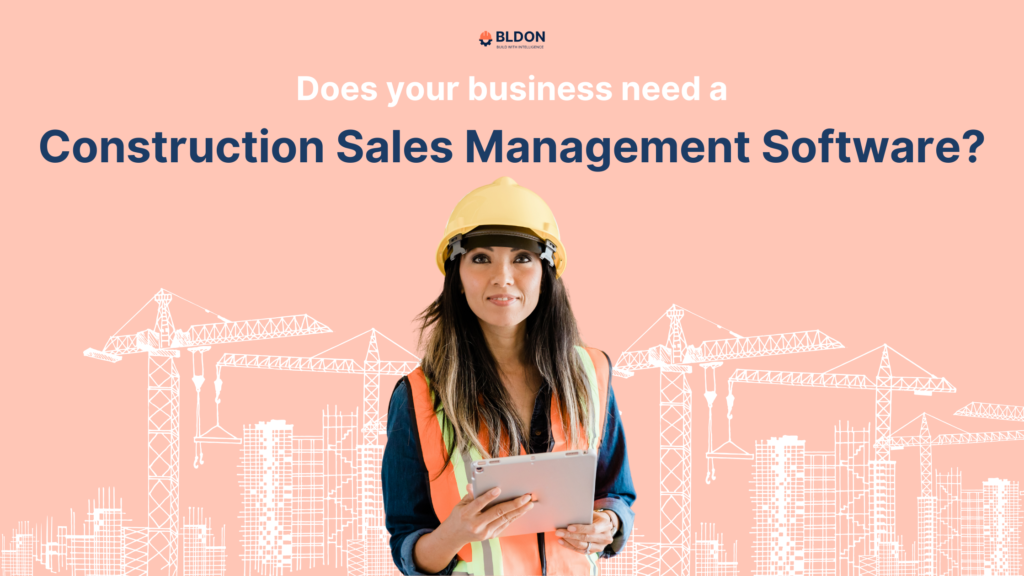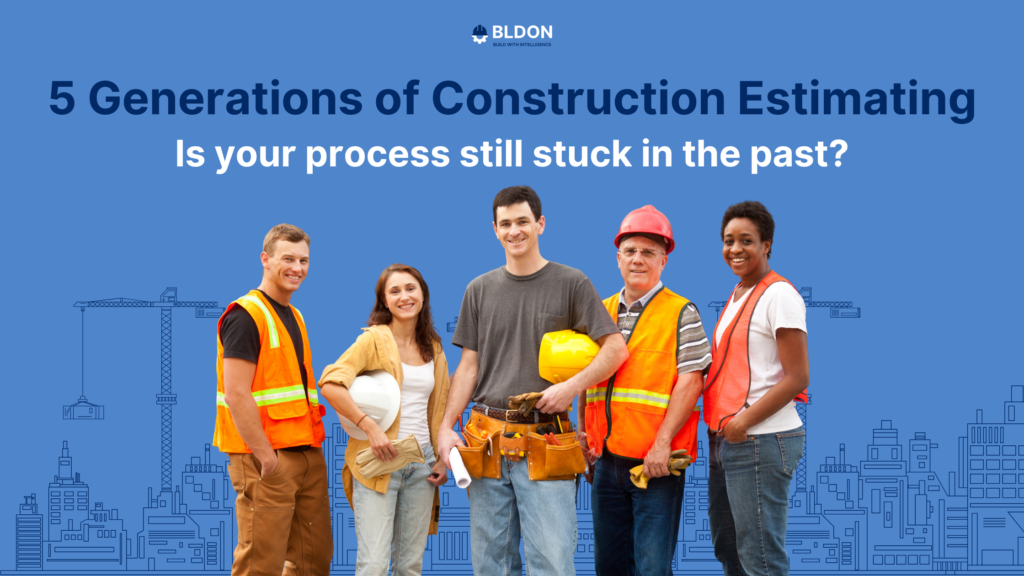
Introduction
Are you still guessing your project costs while your competitors are using AI to predict them with precision?
You’re not alone. Even today, 85% of construction professionals still rely on Excel for estimating or use costly software without fully leveraging its features. This results in errors and, worse, budget overruns.
But since you’re here, we believe that you’re ready to break that cycle and explore how AI can change your building cost estimation process. But before we jump to the topic, let’s understand how the cost estimation process has evolved through the generations.
- Introduction
- The Evolution of Cost Estimation in Construction
- AI-Powered Techniques in Building Cost Estimation
- Benefits of Implementing AI in Cost Estimation
- Challenges and Considerations
- Future Trends in AI and Construction Cost Estimation
- How to Implement AI for Cost Estimation in Your Construction Business
- Final Thoughts: Why AI Is the Future of Cost Estimation in Construction
- Frequently Asked Questions
The Evolution of Cost Estimation in Construction
Estimating project costs has never been an easy task. It has always been seen as time-consuming and prone to human error. In fact, with traditional methods, cost overruns were a common occurrence. But this changed with the introduction of digital tools. Each generation of cost estimation processes has helped estimators calculate faster and with better accuracy. These tools have also helped them in improving their data management.
However, while the tools are powerful in themselves, many construction professionals fail to fully understand the capabilities of the tools they purchase. As a result, they end up underutilizing them or worse, choosing a tool that doesn’t match their actual needs. It’s like owning a smartphone but using it only for calls and messages.
Therefore, in this blog, we’ll dive deep into AI features and understand their benefits, challenges, and how to implement these tools effectively.
AI-Powered Techniques in Building Cost Estimation
AI helps construction estimators improve project cost estimation with its advanced technologies.
| AI Technology | Function | Key Benefits |
| Machine Learning (ML) | Analyzes vast historical project data to identify patterns and trends | 1) Predicts costs with high precision. 2) Can reduce construction costs up to 20%. 3) Saves up to 50% on material waste. 4) Improves accuracy over time with more data |
| Predictive Analytics | Interprets and extracts relevant information from contracts, specs, and regulatory documents | 1) Anticipates budget overruns. 2) Enables proactive decision-making. 3) Offers real-time insights for dynamic project planning |
| Natural Language Processing (NLP) | Interprets and extracts relevant info from contracts, specs, and regulatory documents | 1) Prevents critical details from being overlooked. 2) Automates information extraction. 3) Saves time and reduces manual errors. |
Benefits of Implementing AI in Cost Estimation
Integrating AI into cost estimation processes offers numerous advantages that directly impact a project’s success.
Increased Accuracy
AI minimizes human errors by providing data-driven insights, leading to more reliable cost predictions. This precision is crucial in avoiding budget overruns and ensuring financial resources are allocated appropriately. Studies have indicated that AI estimations can achieve up to 97% accuracy, significantly reducing the margin of error compared to traditional methods.
Time Efficiency
Automating complex calculations and data analysis accelerates the estimation process. This efficiency allows project teams to focus on strategic planning and execution rather than getting bogged down by manual computations. The expedited process not only saves time but also enables quicker decision-making, which is vital in the fast-paced construction industry.
Risk Management
AI’s predictive capabilities enable the early detection of potential cost overruns and project delays. By identifying these risks upfront, teams can implement mitigation strategies proactively, enhancing the likelihood of project success. This foresight is invaluable in navigating the uncertainties inherent in construction projects.
Data-Driven Decision Making
With AI analyzing extensive datasets, decisions are grounded in empirical evidence rather than intuition. This data-driven approach fosters transparency and confidence among stakeholders, leading to more cohesive project management. Access to real-time data and analytics empowers teams to make informed choices, optimizing resource allocation and project timelines.
Challenges and Considerations
While AI offers transformative benefits, its implementation comes with considerations that professionals must address.
Data Quality and Availability
The effectiveness of AI is contingent on the quality and comprehensiveness of the data it analyzes. Incomplete or inaccurate data can lead to flawed predictions. Therefore, establishing robust data collection and management practices is essential. Ensuring data integrity involves regular audits and updates to maintain the accuracy of the information feeding into AI systems.
Integration with Existing Systems
Incorporating AI solutions requires compatibility with current workflows and software. This integration necessitates careful planning to ensure a seamless transition and to maximize the benefits of AI tools. Training staff to adapt to new technologies is also crucial, as user proficiency directly impacts the effectiveness of AI implementation.
Cost of Implementation
Investing in AI technology involves initial costs that may be substantial. However, the long-term savings achieved through enhanced accuracy and efficiency often justify this investment. Conducting a cost-benefit analysis can help determine the return on investment and guide decision-making. Additionally, scalable AI solutions can be tailored to fit projects of varying sizes, making them accessible to a broader range of firms.
Future Trends in AI and Construction Cost Estimation
As AI continues to evolve, its role in building cost estimation is set to expand even further. Emerging trends indicate that AI-driven solutions will not only enhance accuracy but also redefine how construction professionals plan and execute projects.
1. AI-Integrated Building Information Modeling (BIM)
BIM has already revolutionized project planning by providing detailed 3D models that incorporate design, scheduling, and cost-related data. When combined with AI, BIM can automatically update cost estimations in real time as design changes occur. This integration ensures that cost projections remain accurate throughout the project lifecycle.
For instance, AI-powered BIM tools can analyze historical project costs and suggest more cost-effective materials or construction methods. According to industry reports, projects using AI-enhanced BIM have seen up to 30% reductions in material waste and 20% faster completion times.
2. AI and IoT for Real-Time Cost Monitoring
The Internet of Things (IoT) is playing a critical role in construction, providing real-time tracking of equipment usage, workforce productivity, and material consumption. When combined with AI, IoT devices can feed data directly into cost estimation software, allowing for real-time adjustments to budget forecasts.
For example, if an IoT-enabled sensor detects a shortage of a critical material on-site, AI can instantly suggest alternative suppliers or adjust the budget to account for cost variations. This proactive approach helps prevent unexpected expenses and delays.
3. AI-Driven Automated Bidding and Procurement
AI is also transforming the bidding and procurement process by analyzing multiple supplier bids and selecting the most cost-efficient options based on project needs. Machine learning models evaluate supplier performance, pricing trends, and contract terms to recommend the best choices for contractors.
Some AI-based platforms have reduced procurement costs by up to 15% by eliminating overpricing and improving vendor selection. This automation not only enhances cost accuracy but also speeds up decision-making, allowing construction firms to secure materials and labor more efficiently.
4. AI-Powered Risk Mitigation Strategies
Risk is an inherent part of construction projects, with factors like weather conditions, labor shortages, and market fluctuations impacting costs. AI-based risk assessment tools analyze past project data and external variables to predict potential cost overruns before they happen.
By leveraging historical trends and real-time data, AI can suggest contingency plans for unexpected expenses. A study found that AI-driven risk management strategies have reduced project cost overruns by an average of 18% in large-scale developments.
5. AI for Sustainable Construction Cost Estimation
Sustainability is becoming a key focus in the construction industry, and AI is playing a major role in optimizing cost estimation for green building projects. AI models assess the long-term financial impact of sustainable practices, such as using energy-efficient materials or renewable energy sources.
Studies suggest that AI-driven sustainability analysis can reduce long-term operational costs by up to 25%, making eco-friendly construction more financially viable. By integrating AI into cost estimation, firms can make informed decisions that balance sustainability with profitability.
How to Implement AI for Cost Estimation in Your Construction Business
Adopting AI-driven cost estimation tools requires a strategic approach to ensure seamless integration into existing workflows. Here’s how construction firms can successfully implement AI in their operations:
1. Assess Your Current Estimation Process
Before investing in AI, identify the gaps in your current cost estimation methods. Are you experiencing frequent budget overruns? Is data management inefficient? Understanding these pain points will help you choose the right AI-powered solution.
2. Choose an AI Solution That Fits Your Needs
Not all AI-powered estimation tools are created equal. Some are designed for large-scale infrastructure projects, while others cater to small contractors. Look for a solution that aligns with your project size, budget, and specific requirements.
Key features to consider:
- Historical data analysis for better cost predictions
- Integration with existing construction software (BIM, ERP, etc.)
- Predictive analytics for real-time cost adjustments
- AI-powered procurement recommendations
3. Train Your Team for AI Adoption
One of the biggest challenges in AI implementation is the learning curve for construction professionals. Many teams underutilize AI tools because they lack the necessary training. Providing hands-on workshops and user-friendly guides can help your team leverage AI effectively.
4. Ensure High-Quality Data Input
AI’s accuracy depends on the data it processes. Inaccurate or incomplete data can lead to flawed cost estimations. Maintain a structured data collection system to ensure AI receives the right inputs for analysis.
5. Monitor and Optimize AI Performance
AI systems require continuous monitoring to maximize efficiency. Regularly update the software with new project data and adjust algorithms based on real-world performance. A feedback loop between AI predictions and actual project outcomes helps fine-tune the accuracy of cost estimations.
Final Thoughts: Why AI Is the Future of Cost Estimation in Construction
The construction industry is undergoing a digital transformation, and AI is at the forefront of this evolution. By integrating AI-driven cost estimation tools, professionals can improve accuracy, reduce risks, and optimize budgets in ways that were previously impossible.
For construction firms still relying on outdated estimation methods or underutilizing their existing software, AI presents an opportunity to unlock new efficiencies. Whether through machine learning, predictive analytics, or real-time data integration, AI is reshaping how cost estimation is conducted, leading to smarter, more profitable projects.
The future of construction cost estimation is not just about making better guesses; it’s about leveraging data-driven intelligence to make the right financial decisions from the start. Now is the time for you to embrace AI and take full advantage of its potential at bldon.com.
Frequently Asked Questions
1. Can AI completely replace human estimators in construction cost estimation?
An AI estimating tool is very powerful. It can process massive datasets and pick out hidden patterns. In short, it can increase the speed at which takeoffs are done by up to 20% according to Andrew Kleimola, Senior Vice President (Estimating) at Accenture. But, here’s the reality: AI isn’t a replacement; it’s a tool that needs a skilled estimator.
2. How does AI improve the accuracy of construction cost estimates?
Estimators can automate quantity takeoffs using AI and analyse thousands of data points that are almost impossible for a human to do. An AI estimation tool scans architectural drawings (including PDFs and 3D models), detects materials, measurements, and structural components, and converts them into detailed line-item quantities faster than manual methods.
Then, using historical project data, real-time market pricing, labor rates, and region-specific variables, AI applies machine learning algorithms to calculate cost predictions. These algorithms identify trends (like how material prices fluctuate based on location or season) and flag risks, helping estimators avoid underquoting or overbudgeting. BLDON is one of the top AI tools for construction budget forecasting
In short, AI does the measuring, counting, comparing, and calculating, freeing up estimators to make strategic decisions and adjust for project-specific nuances.
3. What are the challenges of implementing AI in construction cost estimation?
| Challenge | Details |
| Data Quality & Availability | Data in the construction industry is often scattered across spreadsheets, PDFs, emails, and subcontractor apps. Many datasets are incomplete, inconsistent, or duplicated. This makes it hard for AI to ingest and process data accurately. |
| Security & Privacy | According to industry reports, poor data quality costs the global construction sector $1.8 trillion annually, with 95% of all construction data going unused due to incompleteness or inconsistency. |
| Integration Complexity | As per sources, AI systems often require access to sensitive project data, raising serious concerns around privacy, intellectual property, and regulatory compliance especially for firms operating across locations. |
| High Costs | Some organizations report that 75% of AI projects fail to scale, with operational integration and poor data infrastructure being key blockers. |
| Workforce & Change Resistance | AI solutions, especially those using deep learning or real-time analytics, require powerful hardware, cloud infrastructure, and ongoing model training and maintenance. These expenses are often prohibitive for smaller firms. |
| Explainability & Trust | Lack of expertise on AI creates resistance to adoption in construction teams. Training, user onboarding, and sustained learning initiatives are necessary to overcome this barrier. |


